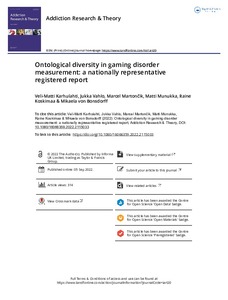Ontological diversity in gaming disorder measurement: a nationally representative registered report
Karhulahti Veli-Matti; Vahlo Jukka; Martoncik Marcel; Munukka Matti; Koskimaa Raine; von Bonsdorff Mikaela
Ontological diversity in gaming disorder measurement: a nationally representative registered report
Karhulahti Veli-Matti
Vahlo Jukka
Martoncik Marcel
Munukka Matti
Koskimaa Raine
von Bonsdorff Mikaela
Taylor & Francis
Julkaisun pysyvä osoite on:
https://urn.fi/URN:NBN:fi-fe2022102463070
https://urn.fi/URN:NBN:fi-fe2022102463070
Tiivistelmä
Gaming-related health problems have been researched since the 1980s with numerous different ontologies as reference systems, from self-assessed 'game addiction' to 'pathological gambling' (in the Diagnostic and Statistical Manual of Mental Disorders [DSM]-IV), 'internet gaming disorder' (in the third section of the DSM-5) and most recently 'gaming disorder' (in the International Classification of Diseases [ICD]-11). Our goal was to investigate how screening instruments that derive from different ontologies differ in identifying associated problem groups. By using four central screening instruments, each representing a different ontological basis, we hypothesized differences and similarities in prevalence, overlap, and health. A nationally representative (N = 8217) sample of Finnish participants was collected. The screening instruments produced significantly different prevalence rates (from 0.4% to 6.9%) and the binomial probabilities of group overlap ranged from poor (0.419) to good (0.919). Expectedly, the problem groups had lower mental health than the general population, yet exploratory analyses implied equivalent or significantly higher physical health. We also found strong exploratory evidence for mischievous responding to complicate the measurement of gaming problems. Considering that several major differences were confirmed between the four gaming problem constructs, we recommend researchers to clearly define their construct of interest, i.e. whether they are studying the ICD-11 based official mental disorder, the DSM-5 proposed 'internet gaming disorder', or other gaming problems-especially in future meta-analyses.
Kokoelmat
- Rinnakkaistallenteet [27094]
